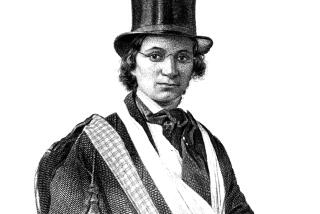‘12 Years a Slave’: John Ridley let Solomon Northup do the talking
- Share via
A nearly universal desire among writers is to make themselves conspicuous in their work. It’s completely understandable. When a script that you’ve spent months — if not years — writing has your name on the title page, who wouldn’t want the material inside to crackle with style; full of snappy rejoinders that audiences gleefully repeat as they exit the theater. Moments that scream: “I wrote that.”
Having worked the whole of my professional life toward achieving such, it’s kind of ironic that in adapting Solomon Northup’s “Twelve Years a Slave” I would end up taking the exact opposite approach. From my very first reading of his memoir it was clear that whatever else was required in translating the book to the screen, what would be most needed was as little of “me” as possible.
I don’t think I’m being hyperbolic when I say that Solomon’s memoir is one of the most singular documents I’ve ever read. It is richly evocative in the way scenes are rendered. It’s filled with eloquent language and is unparalleled in its urgency. It’s an urgency that wasn’t arrived at by happenstance. Solomon’s is one of comparatively few first-person narratives written by someone who’s lived to tell the tale of the inhuman and murderous American slave system. At a time when the ability to read or write was for slaves a death sentence, Solomon used all of himself — his wits, his guile, his physicality — to survive his ordeal. Completing the book within a year of his liberation gave his words veracity and an emotional velocity that could not be enhanced, but in my opinion only diminished, by artifice.
ON LOCATION: ’12 Years a Slave’
Believing that, I approached the work as something of a restoration project. I set my mission as being reductive — honing the narrative, or excavating moments in the story that were referenced, but not fully rendered — while avoiding the temptation to be additive: slapping on some modern perspective about slavery because I thought there was some other, better, more present-day thing to say. At the same time, I did not wish to bend or shape the narrative in conventional ways. Solomon’s story was life, real and true, and it played out on its own without manufactured arcs. It didn’t need to be declarative, merely experienced.
There may have been an inclination, a natural one, for Solomon as a “heroic” character to have been more proactive or even reactive in certain circumstances. To modify the man, no matter how sincere the desire, would have ultimately been dishonest.
Solomon’s story begs for honesty. As the voice of his own history, what he wrote deserved fidelity.
PHOTOS: Scenes from ’12 Years a Slave’
The beauty Solomon sees in a bleak environment, the faith he maintains against all reason, speaks for itself. Equally, the hard realities of slavery and the matter-of-fact manner in which the most minor of transgressions is met with the most brutal violence, are depicted in such a vivid manner there was no need to aggrandize them. Solomon recounted events as he had lived them; with an immediacy that resonates to this day.
With all that as my starting point, my basic ethos over the four years I worked on the script was to insert myself the least amount necessary. But when I did, to then execute to the highest degree possible.
A chore made all the more feasible when blessed with a crew and cast that shared equally the desire to be faithful to the source material.
In that regard, above all other things, it has been a uniquely humbling experience to have been one part of a group of dedicated individuals who have helped return Solomon Northup’s true story to its rightful place of prominence both here in America and around the world.
More to Read
Only good movies
Get the Indie Focus newsletter, Mark Olsen's weekly guide to the world of cinema.
You may occasionally receive promotional content from the Los Angeles Times.










